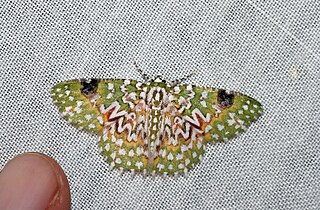
Omiodes is a moth genus in the family Crambidae. Several species are endemic to Hawaii.

Nepita is a monotypic moth genus in the subfamily Arctiinae erected by Frederic Moore in 1860. Its only species, Nepita conferta, the footman moth, was first described by Francis Walker in 1854. It is found in India and Sri Lanka.

Pyrausta is a speciose genus of moths of the family Crambidae. The genus was erected by Franz von Paula Schrank in 1802.

Eucyclodes gavissima, the Oriental orange banded green geometer moth, is a species of moth of the family Geometridae described by Francis Walker in 1861. It is found in the Indian subregion, Sri Lanka, Bhutan, western China, Taiwan, Sumatra and Borneo.

Spilosoma latiradiata is a moth in the family Erebidae. It was described by George Hampson in 1901. It is found in South Africa and Zambia.
Pyrausta aurea is a moth in the family Crambidae. It was described by George Hampson in 1913. It is found from Nevada, southern Arizona, southern Texas and Mexico south at least to Costa Rica.
Pyrausta phaeophoenica is a moth in the family Crambidae described by George Hampson in 1899. It is found in Paraná, Brazil.
Pyrausta pyrocausta is a moth in the family Crambidae described by George Hampson in 1899. It is found in the Brazilian states of São Paulo and Paraná.
Pyrausta tenuilinea is a moth in the family Crambidae. It was described by George Hampson in 1913 and it is found in Panama.
Pyrausta cardinalis is a moth in the family Crambidae. It was described by Achille Guenée in 1854. It is found in Florida, Cuba, the Dominican Republic and on the Virgin Islands and Puerto Rico.
Pyrausta tetraplagalis is a moth in the family Crambidae. It is found in the Democratic Republic of Congo and Zimbabwe.
Pyrausta perlelegans is a moth in the family Crambidae described by George Hampson in 1898. It is found in Colombia and Peru.

Agrotera endoxantha is a moth in the family Crambidae. It was described by George Hampson in 1898. It is found in New Guinea.
Agrotera setipes is a moth in the family Crambidae. It was described by George Hampson in 1898. It is found in Indonesia, where it has been recorded from the Natuna Islands.
Pilocrocis dichocrosialis is a moth in the family Crambidae. It was described by George Hampson in 1912. It is found in Cameroon, the Democratic Republic of the Congo (Katanga), Malawi, Mozambique, Zambia and Zimbabwe.
Pycnarmon argenticincta is a moth in the family Crambidae. It was described by George Hampson in 1899. It is found on New Guinea.
Talanga talangalis is a moth in the family Crambidae. It was described by George Hampson in 1899. It is found in the Loyalty Islands in the Pacific Ocean east of Australia.
Microblepsis cupreogrisea is a moth in the family Drepanidae. It was described by George Hampson in 1895. It is found in Myanmar, the north-eastern Himalayas and on Borneo and Sumatra.
Ambia xantholeuca is a moth in the family Crambidae first described by George Hampson in 1896. It is found in Sri Lanka.

Xenochroa chlorostigma is a moth of the family Nolidae first described by George Hampson in 1893. It is found in India, Sri Lanka, Himalaya, Sundaland, Philippines and Sulawesi.






